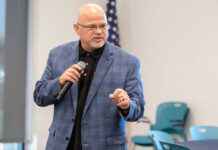
Rochelle didn’t know exactly what the Red Cross did until Hurricane Ike wreaked havoc on her home. She and her husband were clearing out moldy carpet and other toxic items from their house, tired and discouraged by the size of the task, when a Red Cross mobile feeding unit showed up with a breakfast of biscuits, gravy and scrambled eggs. It made all the difference.
“A hot breakfast was such a great way to start the day’s work,” she says. Rochelle was also given bottles of water and a Red Cross clean-up kit with a bucket, scrub brushes, a mop, a broom, gloves, sponges and bleach. Not much, but critical when your home is flooded.
Shelby and Jessica and their three young children sought safety from Hurricane Ike in a Red Cross shelter. Exhausted from many hours of evacuation travel, the family found cots, three meals a day, hot showers and emotional support. And, thanks to Red Cross volunteers who helped with feeding and other activities, Jessica, pregnant with her fourth child, was able to get some rest, knowing her family was out of harm’s way.
These are just a few of the hundreds of thousands of people the Red Cross has helped during the recent back-to-back hurricanes Gustav and Ike – one of the biggest relief operations in Red Cross history. More than 20,000 Red Cross volunteers have been on the ground providing cots and blankets, hot meals, and hope. More than 900 evacuation centers were opened in 17 states – sheltering nearly 60,000 people at the peak. And while the storms have passed, and the media has moved on, the Red Cross is still there helping.
An operation of this size requires an incredible amount of behind-the-scenes planning and logistics. As hurricanes approach, the Red Cross Disaster Operations Center is continually tracking the weather and moving into position thousands of workers and volunteers, cots and blankets, meals and clean-up kits, communications and Emergency Response Vehicles all across the Gulf region. While we partner with federal, state and local governments, as well as faith-based organizations and community organizations, the American Red Cross is the only nonprofit that can mount a mass care operation on a scale of this size.
This year has put a tremendous strain on Red Cross resources. In addition to the string of storms named Dolly, Fay, Hannah, Gustav and Ike, the Red Cross has responded to a record number of tornadoes, the worst flooding in the Midwest in 15 years and an active wildfire season. And before the year is out, we will have responded to more than 70,000 disasters in communities nationwide – most of them home fires.
At the same time that we are responding to a record number of disasters, the entire country has been hit by an “economic storm” that makes fundraising all the more challenging. As a result, the American Red Cross Disaster Relief Fund is depleted, putting our ability to help disaster victims in jeopardy. We have cut expenses wherever possible and redoubled our fundraising efforts. The American people are responding generously, but we still need to raise more. In the interim, we are borrowing money to cover our costs and fast approaching our borrowing limit.
The American Red Cross has been there at each and every disaster because the American people expect us to be there and because they have always supported us. But we need your help now more than ever. So please support the American Red Cross Disaster Relief Fund. The Disaster Relief Fund ensures relief services such as food, shelter and other basic necessities are available immediately to victims of disasters. Your gift will allow the Red Cross to continue to help families like Rochelle and Jessica’s, whenever and wherever disasters strike. Thank you.
To donate to the Red Cross, please visit www.arizonaredcross.org or call 1-800-842-7349.
Submitted photo









![City gave new manager big low-interest home loan City Manager Ben Bitter speaks during a Chamber of Commerce event at Global Water Resources on April 11, 2024. Bitter discussed the current state of economic development in Maricopa, as well as hinting at lowering property tax rates again. [Monica D. Spencer]](https://www.inmaricopa.com/wp-content/uploads/2024/04/spencer-041124-ben-bitter-chamber-property-taxes-web-218x150.jpg)
![Maricopa restaurateur makes Food Network connection [Namkeen Dhaba]](https://www.inmaricopa.com/wp-content/uploads/2024/04/439456716_377105198650519_7536248579664805896_n-218x150.jpg)

![O’Reilly gears up for second Maricopa location An exterior view of O'Reilly Auto Parts on John Wayne Parkway on May 2, 2024.[Monica D. Spencer]](https://www.inmaricopa.com/wp-content/uploads/2024/05/spencer-050224-oreilly-second-location-web-100x70.jpg)
![Province writer opens the athlete’s mind in new book Tom Schuman, a Province resident, poses with a copy of his new book, "My Wide World of Sports," outside his home on May 2, 2024. [Monica D. Spencer]](https://www.inmaricopa.com/wp-content/uploads/2024/05/spencer-050224-tom-schuman-sports-book-web-01-100x70.jpg)

